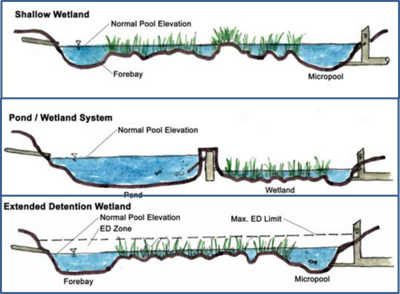
Types of stormwater wetlands
Stormwater wetlands are constructed with varying amounts of the following three components:
- shallow marsh area
- permanent micropool area ( permanent pool)
- storage volume above the normal water level
The amount of each of the components named above depends on the desired type of stormwater wetland (e.g., shallow wetland). The schematic shows the three major types of stormwater wetlands presented in this Manual.
Stormwater wetland design must be tailored to site characteristics; however, some general RECOMMENDED design criteria for shallow wetland, ED shallow wetland, and pond/wetland design are presented below:
Summary of wetland design criteria
Link to this table
| Design Criteria | Shallow Wetland | Pond/Wetland | ED Shallow Wetland* |
|---|---|---|---|
| Wetland/Watershed Ratio (Ac/Ac) | 0.2 | 0.1 | 0.1 |
| Minimum Drainage Area (Ac) | 25 | 10 | 25 |
| Length to Width Ratio (minimum)(ft/ft) | 2:1 | 2:1 | 2:1 |
| Extended Detention (ED) | No | Optional | Yes |
| Allocation of Vwq (pool/marsh/ED) in % | 25/75/0 | 70/30/0(includes pond volume) | 25/25/50 |
| Allocation of Surface Area (deepwater/low marsh/high marsh/semi-wet) in % | 20/35/40/5 | 45/25/25/5 (includes pond surface area) | 10/35/45/10 |
| Forebay | Required | Required | Required |
| Micropool | Required | Required | Required |
| Outlet Configuration | Reverse-slope pipe or hooded broad-crested weir | Reverse-slope pipe or hooded broad-crested weir | Reverse-slope pipe or hooded broad-crested weir |
*Note: The ED Shallow Wetland design guidance does not meet the MPCA requirements for permanent volume. The guidance may be applied in a stormwater retrofit situation where area requirements preclude the use of a Shallow Wetland
The proportions of deep water, low marsh, high marsh, and semi-wet marsh are presented above and are defined below.
- Deepwater zone – From 1.5 to 6 feet deep. Includes the outlet micropool and the deepwater channels through the wetland facility. This zone supports little emergent wetland vegetation but may support submerged or floating vegetation. It is consistent with the Cowardin Wetland Classification of palustrine aquatic beds.
- Low marsh zone – From 6 to 18 inches below the normal permanent pool or water surface elevation. This zone is suitable for the growing of several emergent wetland plant species.
- High marsh zone – From 6 inches below the pool to the normal pool elevation. This zone will support a greater density and diversity of wetland species than the low marsh zone. The high marsh zone should have a higher surface area to volume ratio than the low marsh zone.
- Semi-wet zone – Those areas above the permanent pool that are inundated during larger storm events. This zone supports a number of species that can survive flooding.
Related pages
- Overview for stormwater wetlands
- Types of stormwater wetlands
- Design criteria for stormwater wetlands
- Construction specifications for stormwater wetlands
- Assessing the performance of stormwater wetlands
- Operation and maintenance of stormwater wetlands
- Cost-benefit considerations for stormwater wetlands
- Calculating credits for stormwater wetlands
- References for stormwater wetlands
- Requirements, recommendations and information for using stormwater wetland as a BMP in the MIDS calculator.
This page was last edited on 8 February 2023, at 01:09.


